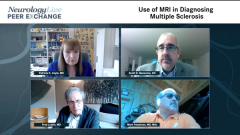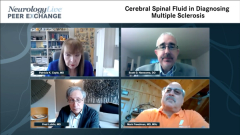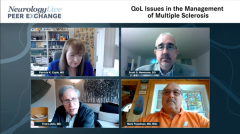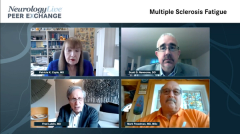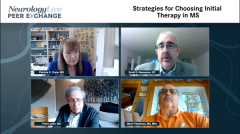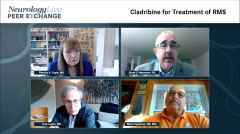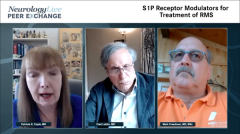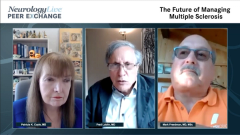
S1P Receptor Modulators for Treatment of RMS
Episodes in this series

The rationale for use of the sphingosine-1-phosphate (S1P) receptor modulators for relapsing multiple sclerosis is outlined by Dr. Patricia K. Coyle.
Fred Lublin, MD: Let’s discuss the sphingosine-1-phosphate [S1P] receptor modulators. We have 3 on the market. One has a successful phase 3 trial, as we just discussed. Tell us about those, Pat.
Patricia K. Coyle, MD: Fingolimod was the first-in-class S1P receptor modulator, and it hits S1P receptors 1, 3, 4, and 5. I will mention a very positive pediatric MS [multiple sclerosis] trial, against IM [intramuscular] interferon beta-1a, in which it did very well.
We now have 2 approved, second-generation S1P receptor modulators. Both of them are aimed at S1P receptors 1 and 5. They deliberately got rid of receptor 3 targeting, which is enriched in the cardiac tissue, in the hopes of getting away from the first-dose, 6-hour observation. Both of them, for the most part, offer you that.
You dose-escalate over the first week or so, and the majority of individuals do not need a formal dose escalation. The first approved was siponimod. What’s a bit special about siponimod is that its phase 3 trial, EXPAND, was in secondary progressive multiple sclerosis [SPMS] individuals. They had to be progressing and gradually worsening. In this trial, which was very large, with over 1600 SPMS patients, individuals were randomized 2 to 1 to siponimod 2 mg daily. They escalated up over the first week vs placebo. The primary outcome was confirmed disability progression at 3 months. This is a progressive population, and they met that primary outcome. They weren’t knock-your-socks-off data. There was an editorial associated that said this may be statistically significant, but is it clinically meaningful? They had about 21% reduction in confirmed disability progression. I think it was 26% vs 32%. You saw benefits on the occasional superimposed relapses and on MRI-detected disease activity in favor of siponimod.
I was impressed with this study. We know that siponimod enters the CNS [central nervous system]. Fingolimod failed, as Fred knows very well, in a phase 3 primary progressive trial. They were able to meet an outcome on progression in SPMS. They were likely hoping to get an approval for secondary progressive MS, and they did not.
What came down for siponimod was an approval for relapsing forms of MS. The FDA made this assessment. That means clinically isolated relapsing-remitting and active secondary progressive MS. They were using analyses that indicated that if the secondary progressive individual had a focal inflammatory component with clinical attacks in the 2 years prior and enhancement on the entry, you could show stronger data. I get that, but they entered secondary progressive MS.
I would like to know if this is an agent that enters the CNS and has a direct impact in decreasing neurodegeneration, unlike and anti-CD20 monoclonal antibodies. Those do not get in. There is less than 0.1% penetrance. But that was enough for ocrelizumab to get approved. I would like to see data that help me understand that better. Siponimod is on the market now. It is certainly being used on secondary progressive patients. You do need to do genotyping.
The other second-generation S1P receptor modulator is ozanimod. That was studied in 2 phase 3 trials in relapsing MS. Radiance was a 2-year study, and SUNBEAM was a 1-year study. Ozanimod is interesting because it breaks down to 2 active metabolites, as well as ozanimod. The metabolites have a longer half-life, so the drug does take longer to wash out. The label has a bit of a concern about other drugs like MAO inhibitors and anything that might cause a serotonin surge. I would think about avoiding those. We need better data there. It went up against IM interferon beta-1a weekly. It didn’t meet disability with pooled data from Radiance and SUNBEAM, but it certainly had good relapse data and MRI data, which favored it. It does give us an alternative choice to fingolimod. We’re dealing with fingolimod, siponimod, and ozanimod. We’re likely to have ponesimod. It’s going to be a very crowded field among the S1P receptor modulators.
Newsletter
Keep your finger on the pulse of neurology—subscribe to NeurologyLive for expert interviews, new data, and breakthrough treatment updates.

